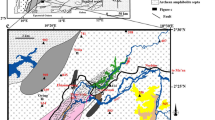Abstract
The City of Bath is located in a steep-sided valley eroded through the competent, thickly bedded limestones and incompetent, weak mudrocks of the Lower and Middle Jurassic. In the Pleistocene, two types of camber developed; their engineering significance is discussed. In addition, a number of large landslides occurred in the valley of the River Avon during the Pleistocene. Historically, smaller landslides developed within these, one of which resulted in the destruction of 135 houses while another accounts for the presence of an asymmetric crescent in this world-famous Georgian city.
Resumé
La ville de Bath est située dans une vallée encaissée qui était érodée par les calcaires compétents en couches épaisses, et les argiles faibles et incompétentes du Jurassic Bas et Moyen. Au Pléistocène, deux types de bombement se sont développés; leur signification pour le génie est discutée. Plusieurs grands éboulements de terrain se sont produits dans la vallée de la Rivière Avon pendant le Pléistocène. Historiquement, de plus petits éboulements de terrain s’y sont développés, dont l’un a entraîné la destruction de 135 maisons tandis qu’un autre explique la présence d’une rue en arc de cercle asymétrique dans cette ville géorgienne de renommée mondiale.
























Similar content being viewed by others
References
Barton ME, Palmer SN, Wong YL (1986) A geotechnical investigation of two Hampshire Tertiary Sand Beds: are they locked sands? Q J Eng Geol 19:399–412
Cox BM, Sumbler MG, Ivimey-Cook HC (1999) A formational framework for the Lower Jurassic of England and Wales (Onshore Area). British Geological Survey, Research Report No RR/99/01
Harcourt Masters C (1810) The Georgian buildings of Bath from 1700–1830. In: Ison N (ed) (1948), Faber & Faber, London
Harmer FW (1907) On the origin of certain canon-like valleys associated with lake-like areas of depression. Q J Geol Soc Lond 63:470–514
Hawkins AB (1977a) Jurassic rocks of the Bath area. In: Savage RG (ed). Geological excursions in the Bristol District, University of Bristol, United Kingdom, pp 119–133
Hawkins AB (1977b) The Hedgemead landslip, Bath, Avon. In: Geddes JD (ed) Large ground movements and structures, Pentech Press, pp 472–498
Hawkins AB, Kellaway GA (1970) Field meeting at Bristol and Bath with special reference to new evidence of glaciation. Proc Geol Assoc 82:267–291
Hawkins AB, McDonald C (1992) Decalcification and residual shear strength reduction in Fuller’s Earth Clay. Geotechnique 42:453–464
Hawkins AB, Privett KD (1981) A building site on cambered ground at Radstock, Avon. Q J Eng Geol 14:151–168
Hollingworth SE, Taylor JH, Kellaway GA (1944) Large-scale superficial structures in the Northampton Ironstone Field. Q J Geol Soc Lond 100:1–44
Ison N (1948) The Georgian buildings of Bath from 1700–1830. Faber & Faber, London
Kellaway GA, Taylor JH (1968) The influence of landslipping on the development of the city of Bath, England. Proceedings of the 23rd International Geological Congress. Czechoslovakia 12:65–76
Phillips J (1844) Memoirs of William Smith, LL.D. Torrens H (2003) Bath Royal Literary and Scientific Institution, p 230
Richardson L (1907) The Inferior Oolite and contiguous deposits of the Bath-Doulting district. Q J Geol Soc Lond 63:383–423
Self CA (1995) The relationship between the gull cave, Sally’s Rift and the development of the river Avon east of Bath. Proc Univ Bristol Spelaeol Soc 210:91–102
Woodward HR (1876) Geology of East Somerset and the Bristol coal-fields. British Geological Survey, p 271
Acknowledgments
The author is grateful to Marcus Hawkins for preparing the diagrams.
Author information
Authors and Affiliations
Corresponding author
Rights and permissions
About this article
Cite this article
Hawkins, A.B. Engineering significance of superficial structures and landslides in the Bath area, UK. Bull Eng Geol Environ 72, 353–370 (2013). https://doi.org/10.1007/s10064-013-0481-8
Received:
Accepted:
Published:
Issue Date:
DOI: https://doi.org/10.1007/s10064-013-0481-8




